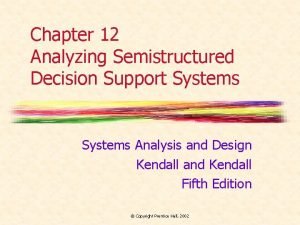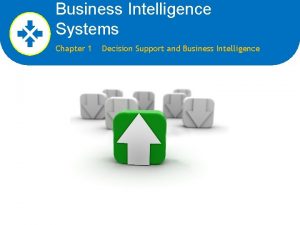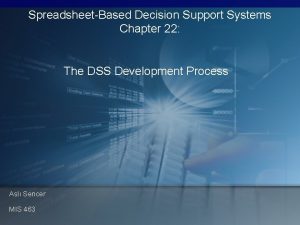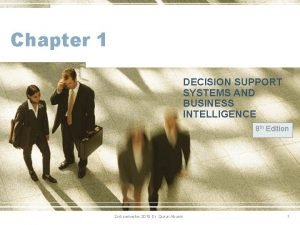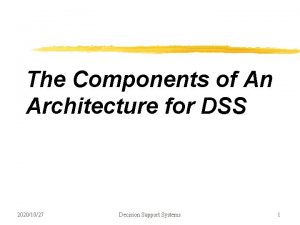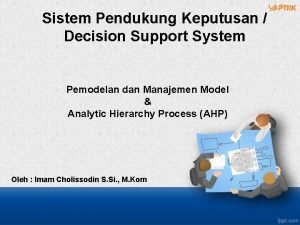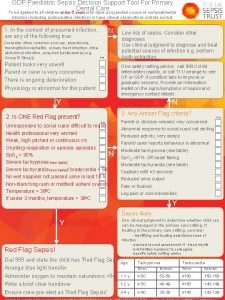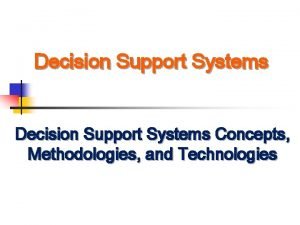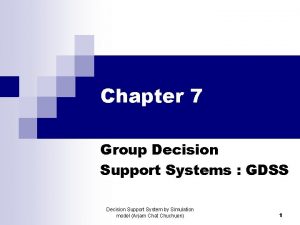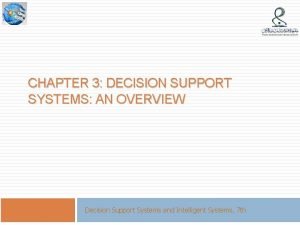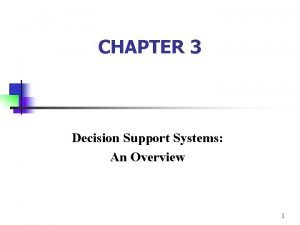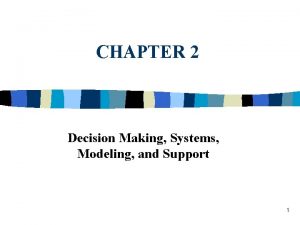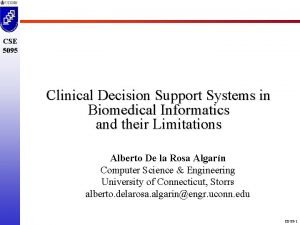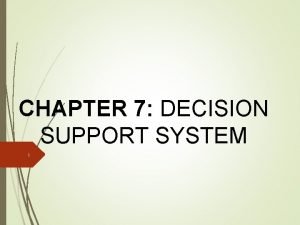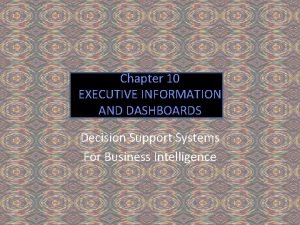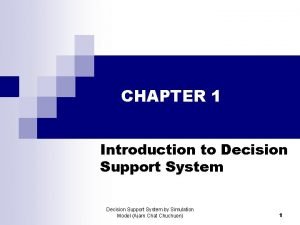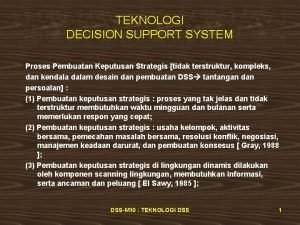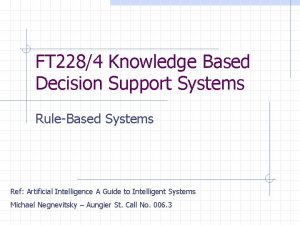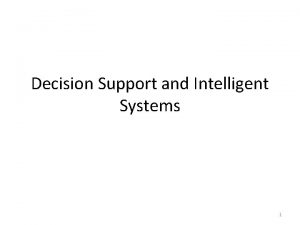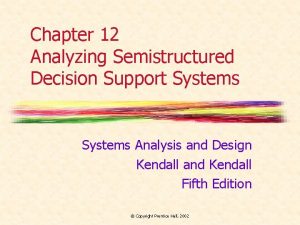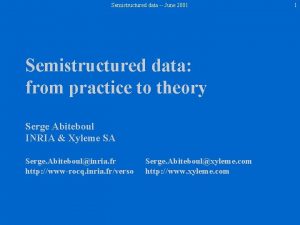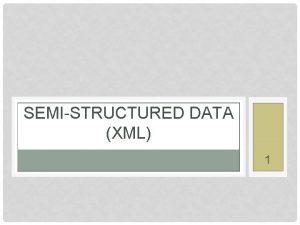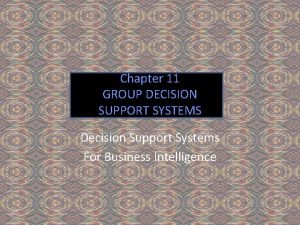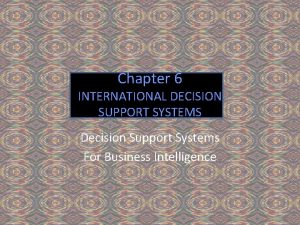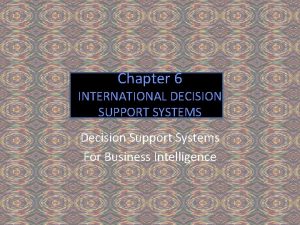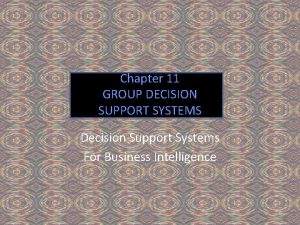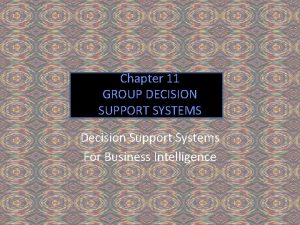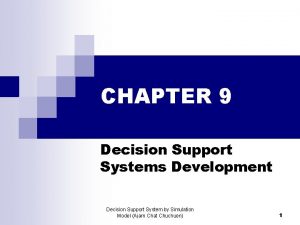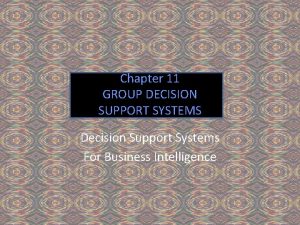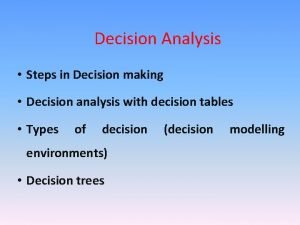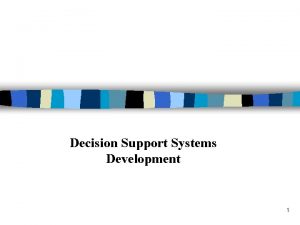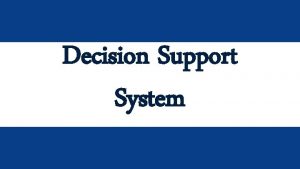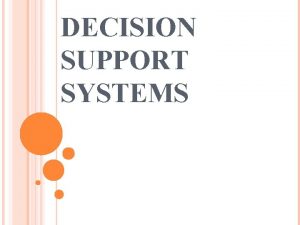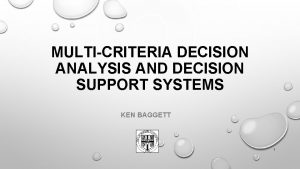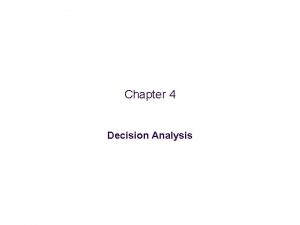Chapter 12 Analyzing Semistructured Decision Support Systems Analysis


































- Slides: 34

Chapter 12 Analyzing Semistructured Decision Support Systems Analysis and Design Kendall and Kendall Fifth Edition © Copyright Prentice Hall, 2002

Major Topics n n n Decision support systems Decision-making style Analytic and heuristic decision making Intelligence, choice, and design Semistructured decisions Decision support system methods Kendall & Kendall Copyright © 2002 by Prentice Hall, Inc. 2

Decision Support Systems n n Decision support systems are a class of information systems that emphasize the process of decision making and changing users through their interaction with the system Decision support systems are well suited for addressing semistructured problems where human judgment is still desired or required Kendall & Kendall Copyright © 2002 by Prentice Hall, Inc. 3

Decision Support Systems n Decision support systems function to n n n Organize information for decision situations Interact with decision makers Expand the decision maker's horizons Present information for decision-maker understanding Add structure to decisions Use multiple-criteria decision-making models Kendall & Kendall Copyright © 2002 by Prentice Hall, Inc. 4

Decision Support System Users n Decision support systems support the decision-making process by helping the user explore and analyze alternatives through different modeling techniques Kendall & Kendall Copyright © 2002 by Prentice Hall, Inc. 5

Decision Making Under Risk n Decisions are made under three’ sets of conditions: n Certainty n n Uncertainty n n The decision makers know everything in advance of making the decision The decision makers know nothing about the probabilities or the consequences of decisions Risk Kendall & Kendall Copyright © 2002 by Prentice Hall, Inc. 6

Decision-Making Style n Decision-making styles of users are categorized as either n n Analytic or Heuristic Kendall & Kendall Copyright © 2002 by Prentice Hall, Inc. 7

Analytic Decision Making n n n Relies on information that is systematically acquired and systematically evaluated to narrow alternatives and make a choice Use methodical, step-by-step procedures to make decisions Value quantitative information and the models that generate and use it Kendall & Kendall Copyright © 2002 by Prentice Hall, Inc. 8

Analytic Decision Making n n n Use mathematics to model problems and algorithms to solve them They seek optimal rather than completely satisfying solutions They use decision techniques such as graphing, probability models, and mathematical techniques to ensure a sound decision-making process Kendall & Kendall Copyright © 2002 by Prentice Hall, Inc. 9

Heuristic Decision Making n n n A heuristic decision maker makes decisions with the aid of guidelines which are not necessarily applied consistently or systematically It is experienced-based Learn by acting, use trial and error to find solutions, and rely on common sense to guide them Kendall & Kendall Copyright © 2002 by Prentice Hall, Inc. 10

Analytic and Heuristic Decision Making Kendall & Kendall Copyright © 2002 by Prentice Hall, Inc. 11

Intelligence, Choice, and Design n The decision-making process is divided into n n n Intelligence Choice, and Design phases Kendall & Kendall Copyright © 2002 by Prentice Hall, Inc. 12

Intelligence Phase n The intelligence phase involves the decision maker n n Searching the external and internal business environment Checking for n n n Kendall & Kendall Decisions to make Problems to solve Opportunities to examine Copyright © 2002 by Prentice Hall, Inc. 13

Intelligence Phase n A DSS can support this phase by having mechanisms for n n Kendall & Kendall Recognizing problems Defining problems Determining the scope of problems Assigning priorities to problems Copyright © 2002 by Prentice Hall, Inc. 14

Choice Phase n n In the choice phase the decision maker chooses a solution to the problem or opportunity A DSS can help by reminding the decision maker what methods of choice are appropriate for the problem and by helping to organize and present the information Kendall & Kendall Copyright © 2002 by Prentice Hall, Inc. 15

Design Phase n In the design phase n n n The decision maker formulates the problem Generates alternatives Analyzes the alternatives Kendall & Kendall Copyright © 2002 by Prentice Hall, Inc. 16

Design Phase n A DSS can supports this phase by n n Generating alternatives that might not occur to the decision maker Quantifying or describing data, retrieving data, collecting new data, and manipulating data Kendall & Kendall Copyright © 2002 by Prentice Hall, Inc. 17

Semistructured Decisions n n n Structured decisions are those for which all or nearly all the variables are known and can be totally programmed A semistructured decision is one which is partially programmable, but still requires human judgment "Deep structure" is structure which is present but not yet apparent Kendall & Kendall Copyright © 2002 by Prentice Hall, Inc. 18

Dimensions of Semistructured Decisions n Three dimensions of a semistructured or unstructured decision n Degree of decision-making skill required Degree of problem complexity Number of criteria considered Kendall & Kendall Copyright © 2002 by Prentice Hall, Inc. 19

Semistructured Decisions in Intelligence, Design, Choice Kendall & Kendall Copyright © 2002 by Prentice Hall, Inc. 20

Decision Support System n A decision support system should be able to support multiple-criteria decision making Kendall & Kendall Copyright © 2002 by Prentice Hall, Inc. 21

Decision Support System Methods n n n n Weighing method Sequential elimination by lexicography Sequential elimination by conjunctive constraints Goal programming Analytic Hierarchy Processing (AHP) Expert systems Neural nets Recommendation systems Kendall & Kendall Copyright © 2002 by Prentice Hall, Inc. 22

Weighing Method n The weighing method entails assigning various components of the alternatives a certain percentage and multiplying numerical scores for the components by the percentages Kendall & Kendall Copyright © 2002 by Prentice Hall, Inc. 23

Sequential Elimination by Lexicography n n With the technique of sequential elimination by lexicography, attributes are ranked in order of importance rather than assigned weights Intra-attribute values are specified as with the weighing method Kendall & Kendall Copyright © 2002 by Prentice Hall, Inc. 24

Sequential Elimination by Conjunctive Constraints n With sequential elimination by conjunctive constraints, the decision maker sets constraints and eliminates alternatives that do not satisfy the set of all constraints Kendall & Kendall Copyright © 2002 by Prentice Hall, Inc. 25

Goal Programming n The goal-programming model contains n n Decision and deviational variables Priorities and sometimes weights Goals are set for each of the goal equations Is of limited use as a DSS tool because sensitivity analysis for goal programming is not yet well developed Kendall & Kendall Copyright © 2002 by Prentice Hall, Inc. 26

Analytic Hierarchy Processing (AHP) n n Analytic Hierarchy Processing requires decision makers to judge the relative importance of each criteria and indicate their preference regarding the importance of each alternative criteria A disadvantage of AHP stems from the use of the pairwise method used to evaluate alternatives Kendall & Kendall Copyright © 2002 by Prentice Hall, Inc. 27

Advantage of Analytic Hierarchy Processing n AHP has an ease-of-use advantage over goal programming n n The decision maker does not have to be skilled at formulating goal equations The decision maker does not have to be knowledgeable about goals and priorities Kendall & Kendall Copyright © 2002 by Prentice Hall, Inc. 28

Analytic Hierarchy Processing n The three steps in AHP are n Determine which alternative is preferred over another and by how much, called a pairwise comparison n Comparing two alternatives to determine which is preferred and by how much Repeat the process for each criteria Rate each of the criteria according to its importance Kendall & Kendall Copyright © 2002 by Prentice Hall, Inc. 29

Expert Systems n Expert systems are rule-based reasoning systems developed around an expert in the field Kendall & Kendall Copyright © 2002 by Prentice Hall, Inc. 30

Neural Nets n Neural nets are developed by solving a number of a specific type of problems and getting feedback on the decisions, then observing what was involved in successful decisions Kendall & Kendall Copyright © 2002 by Prentice Hall, Inc. 31

Recommendation Systems n n n Recommendation systems are software and database systems that reduce the number of alternatives by ranking, counting, or some other method A recommendation system that does not use weights It simply counts the number of occurrences Kendall & Kendall Copyright © 2002 by Prentice Hall, Inc. 32

World Wide Web and Decision Making - Push and Pull n n n The World Wide Web may be used to extract decision-making information Push technologies automatically deliver new Internet information to a desktop Intelligent agents learn your personality and behavior and track topics that you might be interested in based on what it has learned Kendall & Kendall Copyright © 2002 by Prentice Hall, Inc. 33

Simulations n n Simulations may be used to make decisions The user constructs a simulation and interacts with it to analyze situations Kendall & Kendall Copyright © 2002 by Prentice Hall, Inc. 34
 Semistructured decision
Semistructured decision Decision support systems and intelligent systems
Decision support systems and intelligent systems No decision snap decision responsible decision
No decision snap decision responsible decision Slidetodoc.com
Slidetodoc.com Decision support and business intelligence systems
Decision support and business intelligence systems Developing spreadsheet-based decision support systems
Developing spreadsheet-based decision support systems Decision support system in business intelligence
Decision support system in business intelligence Decision support system vs expert system
Decision support system vs expert system Chapter 2 economic systems and decision making
Chapter 2 economic systems and decision making Chapter 2 economic systems and decision making
Chapter 2 economic systems and decision making Chapter 2 economic systems and decision making
Chapter 2 economic systems and decision making Data dictionary system analysis and design
Data dictionary system analysis and design Decision tree and decision table examples
Decision tree and decision table examples Transaction processing system examples
Transaction processing system examples Dss architecture components
Dss architecture components Contoh decision support system adalah
Contoh decision support system adalah Navify decision support
Navify decision support Gdp sepsis decision support tool
Gdp sepsis decision support tool Components of decision support system
Components of decision support system Components of group decision support system
Components of group decision support system Group decision support and groupware technologies
Group decision support and groupware technologies Bi vs dss
Bi vs dss Components of decision support system
Components of decision support system Systematic decision making process
Systematic decision making process Model driven decision support system
Model driven decision support system Knowledge management decision support
Knowledge management decision support Iliad clinical decision support system
Iliad clinical decision support system Executive support system
Executive support system Objectives of decision support system
Objectives of decision support system Decision support system dashboards
Decision support system dashboards Introduction to decision support system
Introduction to decision support system Proses decision support system
Proses decision support system Knowledge based decision support system
Knowledge based decision support system Benefits of decision support system
Benefits of decision support system Marketing decision support system
Marketing decision support system
